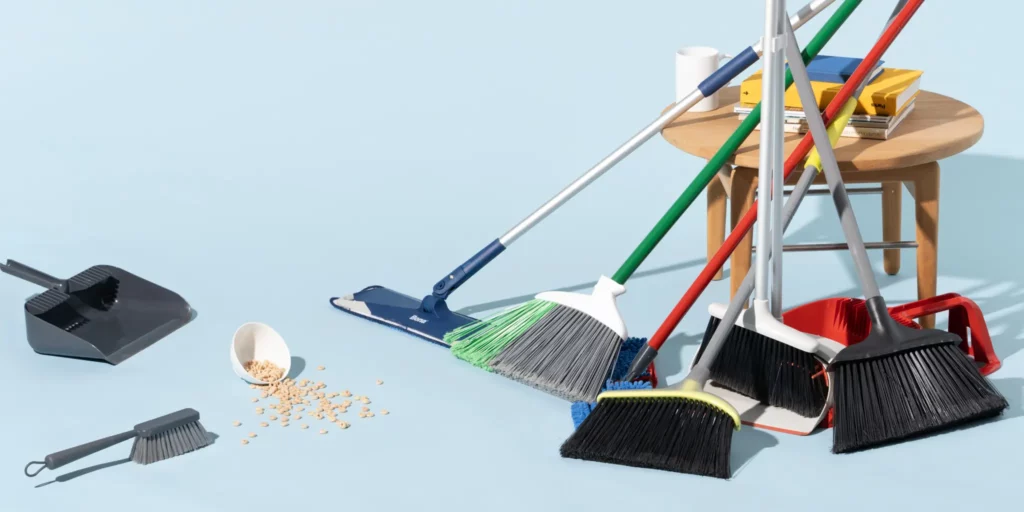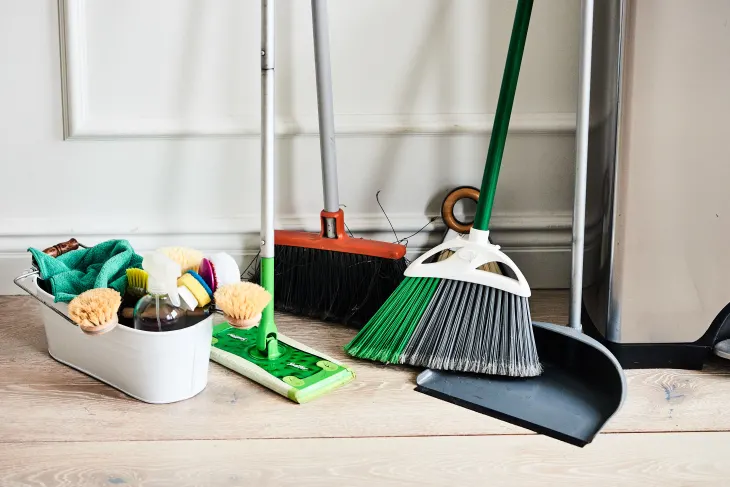Choosing the right broom and dustpan doesn’t have to be complicated. Whether you need lightweight tools for quick cleanups, sturdy options for heavy-duty tasks, or eco-friendly solutions for outdoor spaces, understanding the differences between plastic, metal, and wooden materials is key.
This guide offers a clear comparison to help you select the perfect tools for your needs. By the end, you’ll be equipped with practical insights and ready to upgrade your cleaning routine. Plus, we’ll share tips to keep your tools in great shape for the long run!
For a broader overview of choosing the perfect cleaning tools, don’t miss How To Choose The Right Dust Pans And Brooms – A Buyer’s Guide.
Comparing Plastic, Metal, and Wooden Brooms and Dust Pans
Below is a side-by-side comparison of the three materials:
| Feature | Plastic | Metal | Wooden |
| Durability | Moderate (may crack under pressure) | High (resistant to bending) | High (if treated against moisture) |
| Weight | Lightweight | Moderate to heavy | Moderate |
| Cost | Low | Moderate to high | Moderate |
| Moisture Resistance | Excellent | Rust-prone (if untreated) | Requires treatment |
| Eco-Friendliness | Low (not biodegradable) | Moderate (recyclable) | High (natural and renewable) |
| Best Use Case | Indoor, light cleaning | Industrial, heavy-duty cleaning | Outdoor or rustic environments |
Plastic Brooms and Dust Pans: Lightweight and Affordable

Plastic tools dominate the market due to their affordability and lightweight design. These are ideal for quick clean-ups and everyday use in homes and offices. For example, a plastic dustpan and broom set is perfect for swiftly collecting crumbs after a family meal or tidying up small messes in a busy office kitchen.
- Advantages: Plastic brooms and dustpans resist moisture, making them suitable for wet messes. Their lightweight design makes them easy to handle, even for extended cleaning sessions.
- Limitations: Plastic tools are best suited for light use and are an affordable choice for specific cleaning needs, though they are less ideal for heavy-duty tasks and plastic tools are recyclable in many settings, making them a practical option for short-term needs.
Plastic options work best when you need a cost-effective solution for low-intensity cleaning. For a wide range of dustpans and brooms, visit our cleaning equipment category.
Metal Brooms and Dust Pans: Sturdy and Industrial
Metal brooms and dust pans are designed for heavy-duty cleaning tasks. They’re a popular choice in industrial and commercial settings, such as manufacturing plants, automotive workshops, and construction sites, where their durability and resilience to wear are indispensable.
- Advantages: Known for their durability, metal tools can withstand frequent or intensive use. They often feature powder-coated or stainless-steel finishes to enhance rust resistance.
- Limitations: Metal tools are robust but may require protective coatings or maintenance to avoid rust when used in damp environments.
Choose metal tools if you need robust performance in demanding environments, such as workshops or warehouses. Pair them with industrial cleansers for optimal results. Browse more options here.
Wooden Brooms and Dust Pans: Eco-Friendly and Rustic
Wooden tools offer a timeless and natural appeal. They are often chosen for outdoor cleaning or by eco-conscious buyers.
- Advantages: Wood is a renewable resource and has a sturdy build. Wooden brooms often feature stiff bristles ideal for sweeping uneven surfaces like patios or driveways.
- Limitations: Treated wooden tools are durable and resistant to moisture, ensuring long-term performance even in outdoor settings.
If sustainability and aesthetics matter to you, wooden brooms are an excellent option. Pair them with surface cleaners for eco-friendly outdoor cleaning. Explore eco-friendly options here.
Practical Tips for Choosing the Right Material
- Assess Your Cleaning Needs: For light indoor cleaning, plastic tools are sufficient. For outdoor or heavy-duty tasks, metal or wooden options may perform better.
- Consider Longevity: If you need a long-term solution, metal and treated wood offer superior durability compared to plastic.
- Weigh Sustainability: Wooden tools are more environmentally friendly, while plastic is less so.
- Budget Matters: Plastic tools are affordable, but investing in metal or wooden alternatives can save money over time.
Integrating Materials into Your Cleaning Routine
Selecting the right material is just one part of building an effective cleaning toolkit. Pair your tools with high-quality cleaning agents for optimal results. For more guidance, check out Brushes & Sponges: Everything You Need To Know or explore our comprehensive cleaning supplies category.
Final Thoughts
We hope this guide has provided valuable insights into choosing the ideal dust pans and brooms by comparing plastic, metal, and wooden options. Whether you’re tidying up a cozy home, managing industrial spaces, or embracing sustainable cleaning practices, we’re here to support you every step of the way.
Explore our extensive range of brooms and dustpans, featuring trusted materials and designs tailored to every need. Have questions or need expert advice on finding the perfect cleaning tools? Reach out anytime—we’re always here to help make your cleaning routine easier and more efficient.
– The Droppe Team
Frequently Asked Questions
Yes, mixing materials is common and can help tailor your tools to specific needs, like durability and eco-friendliness.
Treat wooden tools with a protective finish and store them in a dry place to prevent moisture damage.
Metal tools are sturdy but may scratch delicate surfaces. Use with care on softer materials like hardwood floors.
Wooden brooms with stiff bristles are ideal for outdoor areas like patios and driveways.
Many plastic tools are recyclable depending on local facilities. Check for recycling symbols on the product.

















